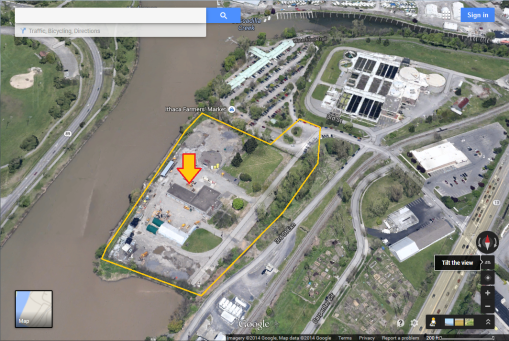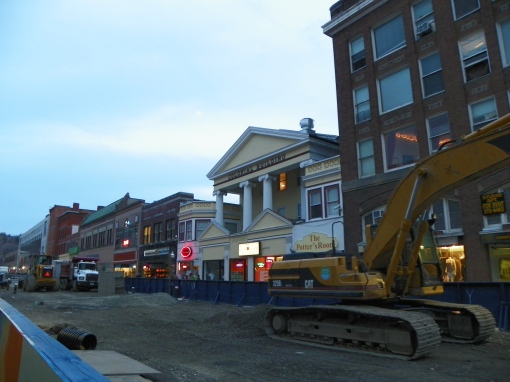With no new projects before the city planning board, and the town cof Ithaca ancelling its planning meetings twice in a row (something that happens only once every couple years), the end of January is shaping up to be a slow period. But that’s not to say there’s no news at all.
1. From the twitter account of local firm Jason K. Demarest Architecture:
No details in the tweet, but I’m getting the impression that the Shen family, who own the Simeon’s building, hired Demarest as the architect for the reconstruction. If that’s the case ( it seems likely, given that the firm handled the expansion of Simeon’s resutaruant in 2009), and this is a preliminary design, then I can only express the greatest of joys that the south facade will be sympathetically rebuilt to its former charm and glory. Fingers crossed.
2. Sticking with the history theme, the city ILPC (Ithaca Landmarks Preservation Council) is considering another historic district, a seven-building district in central Ithaca being called the “Titus-Wood Historic District“. I can think of two reasons for this plan:
I. A historically notable carriage house at the back of 310 W. State Street has been threatened with demolition, much to the dismay of local preservationists. If designated, demolition becomes much more difficult (an “economic hardship” clause has to be invoked and approved by the council).
II. The West State corridor is a target for development under the new Ithaca Comprehensive Plan, which could potentially put the other buildings at risk in the long term.
There’s been no major opposition to the proposal so far, so this is probably good for approval at their next meeting.
3. Also in the same ILPC meeting, a single-family home at 421 N. Albany Street is being considered for historic designation. The house was home to a precursor of the Alpha Phi Alpha fraternity who have sought to purchase the property and restore it as a historic fraternal landmark. The African-American fraternity (the first fraternity of its kind) is also raising money to build a monument at 411 East State Street (shown above, zoning appeal application from last summer here). The 411 East State site is owned by Travis Hyde Properties, and the national fraternity appears to have negotiated use of that part of the property for its monument.
4. Courtesy of the Ithaca Times, we now know the renovation of the furniture store at 206 Taughannock will yield seven apartments and commercial space. The Lehigh Valley House building being renovated next door (covered by Ithaca Builds previously) will host a satellite office of the IPD on its ground floor, with six condos on the upper two floors. 206 Taughannock is being developed by Mark Zaharis, and Lehigh Valley House by Tim Ciaschi.
If Ithaca has any sort of “warehouse district” like the larger cities, Inlet Island is probably the closest comparison. Traditionally, it’s been a blend of commercial and industrial uses, and low-income families whose homes were lost to the construction of the flood control channel in the mid-to-late 1960s. In recent years, with the passage of more amenable zoning and increasing interest/rising land values in Ithaca city, the island and West End have started to receive attention from developers. In the past year, the aforementioned two projects and the 21-unit 323 Taughannock have been proposed and/or started construction, and interested parties are rumored to be waiting on the sidelines, ready to propose their own projects based on the success of these pioneers. Among those interested parties are Tom[kins County and the city of Ithaca, who are busy persuading the state to sell or move out of underused properties so that they can be made available for development.The city has had a strong interest in redeveloping the island for decades.
I think the potential is here for substantial development, and so far, the projects underway are doing well; it’s not remiss to suggest there will be more in the next couple years. But the idea of development is still controversial, with concerns of traffic and loss of local character. I have no doubt it will be a spirited debate.
5. The charitable trust of the Al-Huda Islamic Center has officially purchased the land that will hold the Ithaca area’s first stand-along mosque. The vacant parcel at 112 Graham Road in Lansing was purchased for $64,900 on January 29th. The special permit for a religious building was approved by the village back in August of last year. The cost of construction is expected to be in the range of $600,000, which is to be raised through donations. I have no idea how close they are to their goal, but the land purchase is auspicious.


































































